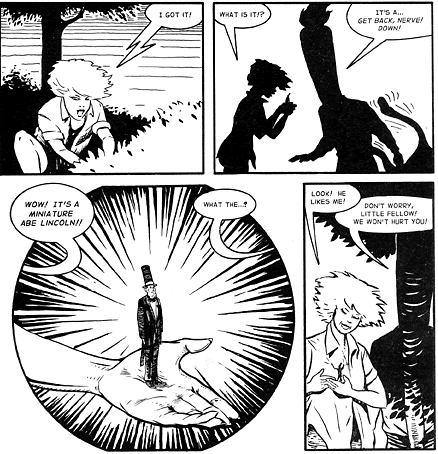|
Rotten Library > Culture > Flaming Carrot
Flaming Carrot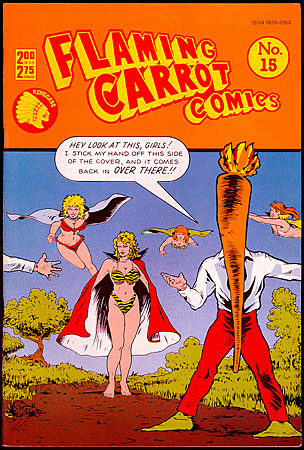 Who is the Flaming Carrot?
Who is the Flaming Carrot?The Flaming Carrot is not your garden-variety super hero. For one thing, he doesn't wear tights. For another, he lives in a strange netherworld of twisted reality that is one-fourth Salvador Dali, one-32nd Batman, one-eighth 23-minute prose poem in the middle of a Doors song, and seven-16ths bad acid trip. Flaming Carrot is the brainchild of Bob Burden, a demented writer and artist whose major claim to fame is, well, Flaming Carrot Comics. The Flaming Carrot debuted with a short story in VISIONS, a limited-run comic anthology, and later moved to his own title. Flaming Carrot is a super hero whose main power is "Zen Stupidity." He wears a gigantic carrot mask with a plume of fire emerging from the top. The bottom of the mask has a secret compartment that holds a collapsible nuclear pogo stick. (Don't ask.) He also wears flippers for shoes (in case he has to swim). The Carrot fights crime just because it's there. When asked why he became a superhero, he responded, "I needed the exercise." His typical crime-fighting strategy is to shoot first and ask questions never. But he's not one of those grim, violent, obsessed warrior types. Flaming Carrot possesses a child-like innocence, which many believe is the product of brain damage.
The Flaming Carrot is a surreal superhero, who lives in Palookaville (a neighborhood in Iron City). His utility belt holds Silly Putty, Pez, a bubble pipe and a wishbone. His enemies include a dead dog, alien swingers and clones of Hitler's feet (yes, just the feet). His friends include the famous inventor Dr. Heller, a potato bug, Uncle Billy and an array of young, buxom, innocent, promiscuous, free-thinking, bootylicious women (generally outfitted in halter tops and Daisy Dukes).
Reading an issue of Flaming Carrot Comics is like taking a trip to an idealized childhood home. Not your real childhood home, with all its issues and dysfunctions, but a strange fantasy childhood, when people were friendly and their actions comprehensible, when everything made perfect sense even if it made no sense at all. The Flaming Carrot's world is plucked from a poetical dream - but not a grand mythic Lovecraftian dream; more of a rambling, free verse, absurdist dream in which one thing leads inexplicably to another, and everything you encounter is familiar, except it's not. (i.e., "We were in my apartment, except it wasn't my apartment. My high school music teacher was dancing on a table, except she wasn't my high school music teacher and it wasn't really a table.")
The mid-1980s were an interesting time for comic books, marking the launch of a series of experimental and independent books that stretched the boundaries of the superhero genre. Flaming Carrot Comics never achieved the mainstream success of its contemporaries, such as Frank Miller's The Dark Knight Returns or the underground hit Teenage Mutant Ninja Turtles - which became a minor pop culture phenomenon by selling out its subversive origins and becoming an example of the kiddie comix it parodied. But FC did make a mark. It scored huge sales for a black-and-white independent book, even outselling Superman one month. Its stylistic influence paved the way for more sophisticated jaunts in comic book storytelling, whether surreal (like Grant Morrison's Doom Patrol) or humorous (like Keith Giffen's Justice League). The Flaming Carrot Comics 31 issues also became bonafide collector items, enjoying sky-high prices during a brief speculative craze during the 1990s (which ended 20 minutes after it began).
The Mysterymen, a mythic alliance of second-string heroes including The Shoveler and Mr. Furious, originally appeared in Flaming Carrot Comics, but the Carrot himself was unfortunately nowhere to be found when the movie came out. Hollywood could still be in the Carrot's future, though. A brand-spanking new Flaming Carrot series is set to debut for Christmas 2004, and frankly, the world has never needed Zen stupidity more.
For instance, the Flaming Carrot once woke up with a mysterious speaker implanted in his chest after a three-day bender. The speaker occasionally activates to impart mysterious instructions, as well as "special insights, secrets of the universe and race track tips." FC doesn't know who implanted the speaker, or what they want from him. A more pressing question: What is the Flaming Carrot's secret identity? Readers never glimpsed the Carrot's real face during the series' run. Burden said in the comic book's letter columns and in subsequent interviews that the Carrot does have a secret identity. Burden has said he would reveal the Carrot's secret identity to any correspondents who correctly guessed it. Although the Carrot's identity was never revealed outright, there are plenty of clues scattered throughout the series:
Maybe we'll find out in the new series. On the other hand, maybe not. If you like stories that wrap up into a tight coherent ball, you might want to stick with Law and Order. In the Flaming Carrot's world, too, too solid facts have a tendency to melt, thaw and resolve themselves into a dew. And that dew then evaporates into a churning fog, which subsequently congeals into a puddle that mysteriously reflects the image of a buffalo head nickel.
|
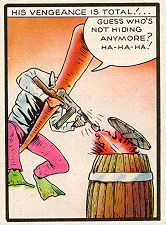 Rumor has it that the Carrot's mind was destroyed after reading 5,000 comic books in one sitting. But his true origin is unknown. His true identity is also unknown, hidden behind his extremely large orange mask.
Rumor has it that the Carrot's mind was destroyed after reading 5,000 comic books in one sitting. But his true origin is unknown. His true identity is also unknown, hidden behind his extremely large orange mask. 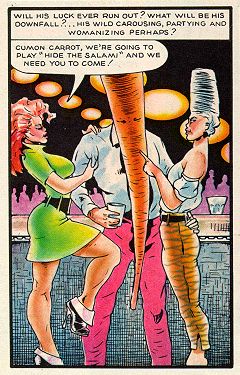 Unlike certain other superheros, who sublimate their sexual urges onto boy sidekicks, Flaming Carrot has an extremely healthy libido, which he indulges with the same fervor he applies to fighting evil. Women are drawn to his strange ways, and they tend to overlook his occasional spells of dementia (relative to his normal, simply bizarre state).
Unlike certain other superheros, who sublimate their sexual urges onto boy sidekicks, Flaming Carrot has an extremely healthy libido, which he indulges with the same fervor he applies to fighting evil. Women are drawn to his strange ways, and they tend to overlook his occasional spells of dementia (relative to his normal, simply bizarre state). 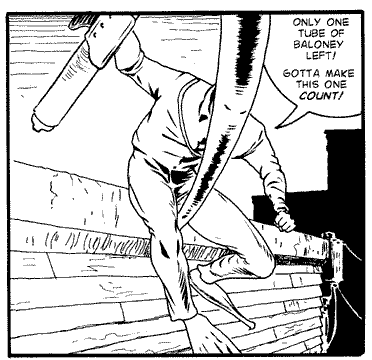 When Flaming Carrot Comics debuted in 1984, it was an overnight sensation among a certain class of socially stunted young adults.
When Flaming Carrot Comics debuted in 1984, it was an overnight sensation among a certain class of socially stunted young adults. 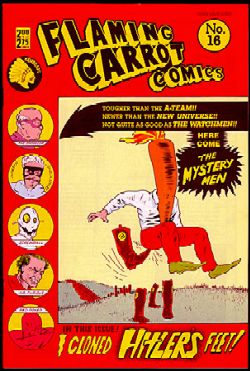 Flaming Carrot was optioned as a movie property for a while, but it never got off the drawing board. A subsequent Bob Burden project - Mysterymen - was made into an extremely unsuccessful Ben Stiller movie (the domestic gross wasn't even half its budget).
Flaming Carrot was optioned as a movie property for a while, but it never got off the drawing board. A subsequent Bob Burden project - Mysterymen - was made into an extremely unsuccessful Ben Stiller movie (the domestic gross wasn't even half its budget). 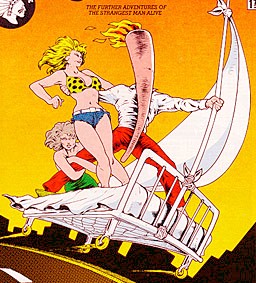 There are a few unanswered questions from the original series will no doubt rear their heads during the new version.
There are a few unanswered questions from the original series will no doubt rear their heads during the new version. 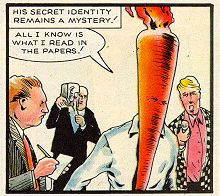 The Flaming Carrot began his career as a superhero during the 1970s.
The Flaming Carrot began his career as a superhero during the 1970s.
